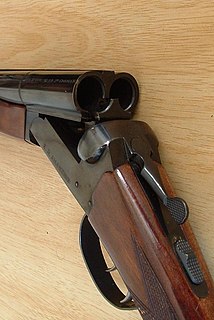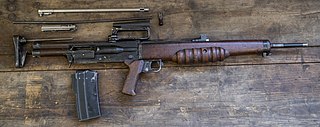
A machine gun is an auto-firing, rifled long-barrel autoloading firearm designed for sustained direct fire with fully powered cartridges. Other automatic firearms such as assault rifles and automatic rifles are typically designed more for firing short bursts rather than continuous firepower, and not considered machine guns. Squad automatic weapons, which fire the same cartridge used by the other riflemen from the same combat unit, are functionally light machine guns though not called so. Submachine guns, which are capable of continuous rapid fire but using handgun cartridges, are also not technically regarded as true machine guns.

In firearms terminology, an action is the functional mechanism of a breech-loading firearm that handles the ammunition cartridges, or the method by which that mechanism works. Actions are technically not present on muzzleloaders, as all those are single-shot firearms with a closed off breech with the powder and projectile manually loaded from the muzzle. Instead, the muzzleloader ignition mechanism is referred to as the lock.
A repeating rifle is a single-barreled rifle capable of repeated discharges between each ammunition reloads. This is typically achieved by having multiple cartridges stored in a magazine and then fed individually into the chamber by a reciprocating bolt, via either a manual or automatic action mechanism, while the act of chambering the round typically also recocks the hammer/striker for the following shot. In common usage, the term "repeating rifle" most often refers specifically to manual repeating rifles, as opposed to self-loading rifles, which use the recoil and/or blowback of the previous shot to cycle the action and load the next round, even though all self-loading firearms are technically a subcategory of repeating firearms.

The CZ 52 is a semi-automatic pistol designed by two brothers, Jan and Jaroslav Kratochvíl, in the early 1950s for the Czechoslovak military. Around 200,000 vz. 52s were made by Česká Zbrojovka in Strakonice from 1952 to 1954. Before standardizing on the 7.62×25mm vz. 52, the Czechoslovak military used several domestic and foreign pistol models in three different calibers. After 30 years of military service, the vz. 52 was eventually replaced by the 9×18mm Makarov caliber vz. 82.
Pump-action or slide-action is a repeating firearm action that is operated manually by moving a sliding handguard on the gun's forestock. When shooting, the sliding forend is pulled rearward to eject any expended cartridge, and then pushed forward to cock the hammer/striker and load a new round of cartridge into the chamber. Most pump-action firearms use an integral tubular magazine, although some do use detachable box magazines. Pump-action is typically associated with shotguns.

The Stoner 63 is a 5.56×45mm NATO modular weapon system. Using a variety of modular components, it can be configured as a rifle, a carbine, a top-fed light machine gun, a belt-fed squad automatic weapon, or a vehicle mounted weapon. Also known as the M63, XM22, XM23, XM207 or the Mk 23 Mod 0 machine gun, it was designed by Eugene Stoner in the early 1960s. Cadillac Gage was the primary manufacturer of the Stoner 63 during its history. The Stoner 63 saw very limited combat use by United States forces during the Vietnam War. A few were also sold to law enforcement agencies.
Blowback is a system of operation for self-loading firearms that obtains energy from the motion of the cartridge case as it is pushed to the rear by expanding gas created by the ignition of the propellant charge.

The M1901 Mannlicher Self-Loading, Semi-Automatic Pistol was an early semi-automatic pistol design.

The Mannlicher M1894 was an early blow-forward semi-automatic pistol.

The Steyr ACR was a prototype flechette-firing assault rifle built for the US Army's Advanced Combat Rifle program of 1989/90. Although the Steyr design proved effective, as did most of the weapons submitted, the entire ACR program ended with none of the entrants achieving performance 100% better than the M16A2, the baseline for a successful ACR weapon.

The EM-2, also known as Rifle, No.9, Mk.1 or Janson rifle, was a British assault rifle. It was briefly adopted by British forces in 1951, but the decision was overturned very shortly thereafter by Winston Churchill's incoming government in an effort to secure NATO standardisation of small arms and ammunition. It was an innovative weapon with the compact bullpup layout, built-in carrying handle and an optical sight.

A bolt is the part of a repeating, breechloading firearm that blocks the rear opening (breech) of the barrel chamber while the propellant burns, and moves back and forward to facilitate loading/unloading of cartridges from the magazine. The firing pin and extractor are often integral parts of the bolt.
The G41 is a German 5.56×45mm NATO assault rifle introduced in 1981 and produced in limited quantities by Heckler & Koch. It was designed to replace the 7.62×51mm NATO chambered Heckler & Koch G3 and the G3 based .223 Remington/5.56×45mm and later 5.56×45mm NATO chambered Heckler & Koch HK33 service rifles providing a more modern weapon compatible with then recently introduced NATO standards. It can use both the then new STANAG 4172 compliant 5.56×45mm NATO SS109, SS110, and SS111 ammunition and older .223 Remington/5.56×45mm M193 ammunition and was the last Heckler & Koch service rifle designed around the roller-delayed blowback mechanism.

The HK21 is a German 7.62 mm general-purpose machine gun, developed in 1961 by small arms manufacturer Heckler & Koch and based on the G3 battle rifle. The weapon is in use with the armed forces of several Asian, African and Latin American countries. It was also license-manufactured by Fábrica de Braço de Prata in Portugal as the m/968 and in Mexico by SEDENA as the MG21. In the German military (Bundeswehr) and the federal police (Bundespolizei) it is designated "G8".

The SIG MG 710-3 is a Swiss 7.62 mm general-purpose machine gun (GPMG) designed and manufactured by SIG - Schweizerische Industrie Gesellschaft. The weapon was developed as a commercial venture primarily for export, since the Swiss Army had already adopted the 7.5 mm MG 51 GPMG, produced by the federal arms factory W+F.
The Ameli is a 5.56mm light machine gun designed for the Spanish Army by the nationally owned and operated Centro de Estudios Técnicos de Materiales Especiales (CETME) small arms research institute.
The Savage Model 110 is a bolt-action repeating rifle made by Savage Arms. It was designed in 1958 by Nicholas L. Brewer. It was patented in 1963. The Model 110 has been in continuous production since that time.

The Thompson Autorifle was a semi-automatic rifle that used a Blish Lock to delay the action of the weapon. It was chambered in .30-06, with the 1923 model in 7.62×54mmR Russian rifle rounds.
Recoil operation is an operating mechanism used to implement locked-breech, autoloading firearms. Recoil operated firearms use the energy of recoil to cycle the action.

A repeating firearm or repeater is any firearm, either a handgun or a long gun that is capable of repeated firing before needing to manually reload new ammunition into the gun. These firearms are breechloading by nature. Different to the preceding single-shot firearms, a repeating firearm can store multiple cartridges inside a magazine, a cylinder or a belt, and uses a moving action to manipulate each of these cartridges into and out of battery position, allowing the gun to discharge numerous times in relatively quick succession before a manual ammunition reload is needed.













